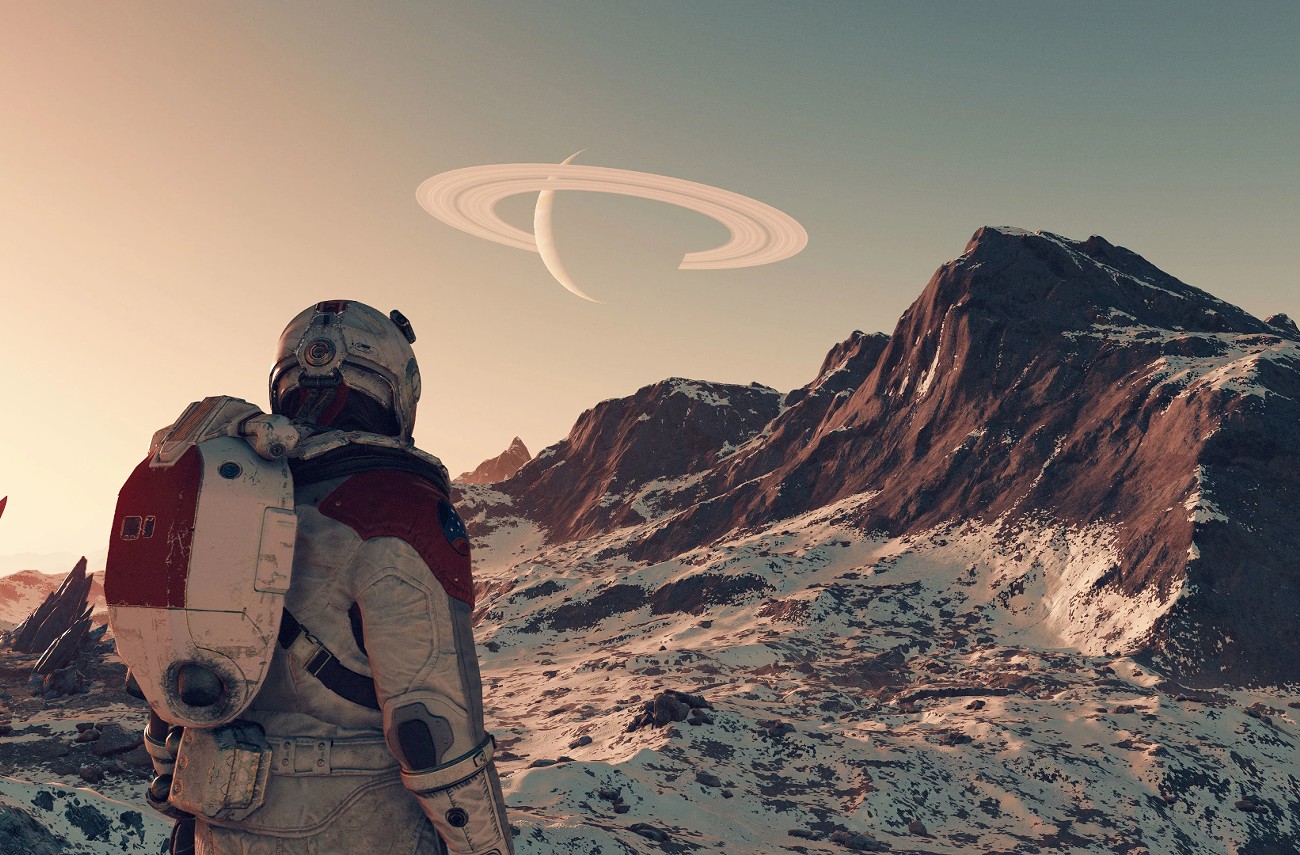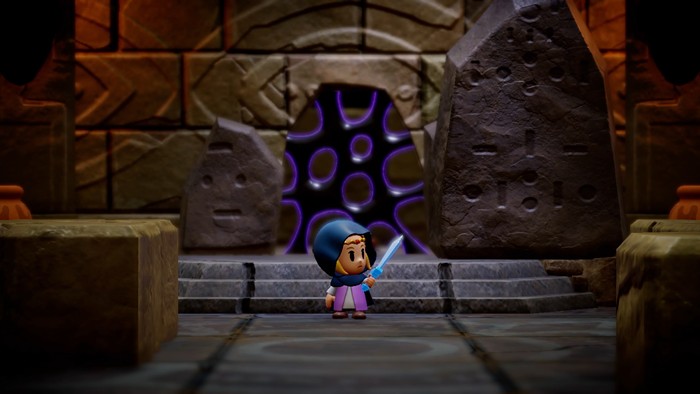Whenever people get their hands on too much technology, power, and time, they will inevitably try to combine them all to get to space. That applies figuratively, like when mankind got civilization to the comfortable point where it could waste time charting stars and figuring out things like gravity, or literally, like how the combustion engine was basically the first step towards launching primates beyond Earth’s atmosphere just to see if they’d suffocate or explode out there.
For over 60 years, video games too have let us launch ourselves as figurative monkeys into the depths of space and invent our own distant destinies. Like classic sci-fi books and films, games in space have their extremes. Do the simple pew-pew-pew thing in Space Invaders. Manage stolen cargo very, very slowly as a deep-space pirate in Elite. Talk at length and get horny with blue- and green-skinned friends in Mass Effect.
Starfield is the latest mega-sized space game to tease an oversized, choices-rich galaxy, and it lands somewhere between those extremes. The new game, out today on Xbox and PCs, is from the same studio that made role-playing game (RPG) hits Fallout and Elder Scrolls: Skyrim—two game names so big, you’ve probably heard them uttered to either confirm nerd cred or explain why someone may have swiped left. (That cred is also one reason Microsoft acquired Starfield’s owners in 2021 for $7.5 billion with a B.)
There’s indeed something cool and interesting inside this massive game—and Starfield arguably earns its place amongst the pop-culture sci-fi constellations. But the massive force of gravity inside Starfield has a little too much in common with a black hole: less that it sucks people in, and more that there’s little light, life, or humanity inside major parts of its core.

Space Crimes and Boring Errands
Imagine a game telling you that you can be the author of your own sci-fi space-faring story, spread across “over 1,000 planets,” and you might be driven to dream. But, really, how far can you go in Starfield? Do you want to be gay in its version of 24th-century space? Or subvert existing cultures’ norms and make choices that lead to interesting moral quandaries? Or establish intriguing relationships by teaming up with multiple spacefaring allies, where the conversations you have with each generate follow-up breadcrumbs that get teased out over 100+ hours of exploration, combat, and discovery?
Sorry, Starfield doesn’t really have those. Although some slight exceptions send you down narrow, linear paths, few break from the prime directive of following a milquetoast space-hero destiny, which is a bummer compared to Fallout and Elder Scrolls games’ options for becoming finely tuned scalawags en route to their endings. Yes, Starfield lets you steal, commit crimes, and accrue a bounty on your head, but it’s more like getting “wanted” police stars in Grand Theft Auto while doing the same tasks anyway, than having your journey re-routed in compelling directions.
Instead of fleshing out your own interesting destiny, Starfield peppers its 1,000 planets with other people’s narrative paths, many in utter isolation from each other. For each memorable, narrative-shifting moment in the universe’s furthest reaches, you’ll stumble across a dozen wayward excuses for pew-pew-pew: run an errand, help a bounty hunter, or stumble upon a pirate outpost where you’re shot on sight, zero opportunity to engender goodwill or BS your way into a drink and a chat. All the while, you’ll find computer terminals and printed books that tell various backstories. Some of these are full of Starfield characters’ diaries and e-mails; others are two- and three-paragraph selections from either fictional, Starfield-era authors, or from real-life authors of our 19th and 20th centuries.
Every time authors like Dickens or Longfellow are quoted this way, the result feels off the mark—as if lifting someone else’s metaphors about human ambition or religion lends this machine-gun-filled video game some level of wisdom or relatability. It’s a little too on-the-nose that these books land in your game character’s inventory, weighted “0.5 lbs,” which means they count against your “carrying” limit and eventually have to be discarded so that you can carry a bigger-ass armor suit instead.

Dumb Murder in Sizeable Quantities
It’s good, then, that many of the game’s story-backed characters are legitimately funny or personable, and most of them come with stellar voice acting. This, sadly, runs in direct opposition to the tech team’s directive to make many of the people look like rejected House of Wax figures. Starfield’s “major” characters all suffer from an uncanny valley effect, made worse by a weird directive to stare directly into the camera during conversations. It’s worse for the non-major characters filling out the game’s cities and outposts; watch out for eye-bulging faces, eerie skin tones, and atrocious haircuts (these are really, really bad for Starfield’s non-major POCs).
Your particular ownership of a Starfield journey, then, will be to make sense of its universe’s warring factions, which vary from drug-fueled underground punks to Fallout-like wastelands of futuristic cowboys. There’s a museum inside the game’s opening settlement, inside the Alpha Centauri system, that breaks the game’s basic lore down in clear-if-overlong fashion, so if you’ve ever wanted a video game to make you feel like you’re at a children’s museum of the future, Starfield has your back. (No screaming kids included.) Once I figured out that this museum existed, without any prompting from the game, I had a much easier time tracking what the heck a Va’ruun was.
This whiplash of confusion into eventual understanding happens a lot in Starfield. Imagine waking up from a coma inside a sci-fi convention 50 years from now, where everyone around you only talks about their favorite holo-injection soap opera series without cluing you into what’s up, and that’s what Starfield often feels like. This applies as much to the storytelling as it does the act of mechanically playing the game. I had no idea how to build a resource-gathering base, expand my spaceship, find and use crafting stations to power up my gear, make sense of “contraband” cargo, or even properly dock my ship to an enemy ship’s in the reaches of space until I accidentally stumbled upon moments where the game said, “Oh, yeah, this thing? Which we didn’t really make any tutorials for? You’re interested? Fine, I’ll tell you, I guess.”
All of Starfield eventually makes a certain sense, but only if you commit to the act of caring about this uneven game—which all of the opening beats dissuade you from. Starfield’s first eight hours are a straight-ahead slog of “primary” and “side” quests, which only teach the game’s bare minimum of useful systems, abilities, and lore. Long loading times interrupt every single time you need to open a door, access a menu, or bring up a map—and, ugh, this game’s map is a real pain to zoom, pan, and scan through, which sucks since you have to use it to actually get anywhere, thanks to every planet requiring a “jump drive” leap across space.
Plus, a huge percentage of the game requires aiming a gun at disagreeable people and shooting them to death, often without a clear sense of whether they really needed to die. There’s enough wanton death in the game’s “good guy” default path to make any player with half a brain question whether there’s a “we’re the bad guys after all” twist coming (spoiler: nope, sorry, you’re just doing the American colonialist thing as you march across space here). That’s made worse by how stupid everyone is; foes dash past or stare at you without shooting, or get into glitchy panics of alternating between running away, rushing you with a wrench in hand, or errantly leaping like Super Mario with PTSD. I never once faced a combat scenario that I found challenging, so if that sounds like a bummer for how you like to run-and-gun in virtual space, be warned: the game doesn’t let you crank up a “difficulty” meter. Dumb murder awaits you here and in sizable quantities.
There’s also the matter of the game screaming at you, via its user interface (UI), that anything you’re staring at might be something you can pick up and put in your pocket. Snacks? They’re yours. Extra guns? Right in the backpack. Leftover mugs and cups? Those have value, steal ‘em, sure. Turns out, sadly, the game slows you down and punishes you for picking up too much stuff. Your in-game companions will even mock you for getting encumbered.
So there you are, playing your supposed “fly all over space and save the galaxies” game, only to find instead you’ve wasted dozens of minutes moving items around a bunch of menus, waiting for loading times, shooting braindead space pirates without appreciating why, or wondering why the game never offered you a mission to open up a warp drive and look for sexy babes of any gender or species on the planet Qumagulon.

Spaceship Dogfights
Here’s the thing: By the time you reach the game’s 18th hour, you will have made your peace with all of the nitpicky stuff outlined above, and figured out each confusing mechanical system folded between the bigger beats, and found some compelling allies, enemies, and passers-by to care about. I believe it is a crime in my home state of Washington to recommend that someone spend 18 hours cracking a sci-fi game’s shell in order to reap a potentially tasty space macadamia inside.
But if your nerd sense tingles at the idea of visiting gorgeous, diverse space scenery—gosh, there’s a lot across all these planets; these artists and designers really did their work—and finding great and weird stories scattered across each, you will find all of that in Starfield. This is by no means a subversive game; advertising materials have described Starfield as “NASA-punk,” as if to imply that a $7.5 billion acquisition might be full of Neil Armstrong and friends flipping the bird, but Microsoft’s smoothing edges are pressed all over the end results, even when atheism, fascism, or homosexuality come up. Still, the human urge to explore the ends of the cosmos, and find some kind of life-changing treasure at each edge, is ultimately respected as you push this game into the 80-hours-and-beyond measure.
The thing is, Starfield’s creators at Bethesda Game Studios have done all this before, in the large-but-more-defined worlds of Fallout and Elder Scrolls. The result reminds me of Wizards of the Coast, the makers of Dungeons & Dragons, occasionally shoehorning outer space into that classic tabletop series. Look through rulebooks like Spelljammer for D&D 5th Edition, and you’ll find the same thing that Starfield does: it warps people out of outer space and into familiar cities, outposts, and dungeons, where they can engage in the rules and systems (and, ya know, gravity) they’re used to.
That’s what Starfield is: occasional leaps into space (and, I will admit, some fun spaceship dogfights) that mostly exist to connect run-and-jump journeys through good ol’ 3D adventuring shit, all grounded by gravity and cumbersome text-filled menus. Know that going in, and burn enough sick days to ensure you reach the good stuff, and you’ll be Starfine. Meanwhile, if you’re eager for a deeper exploration of space in gaming that goes beyond the foundations built by series like Star Trek or The Expanse, I recommend the narrative-heavy, authentically gay I Was A Teenage Exocolonist, the time-bending exploration of Outer Wilds, or the dirt-cheap classic Mass Effect Trilogy.
















